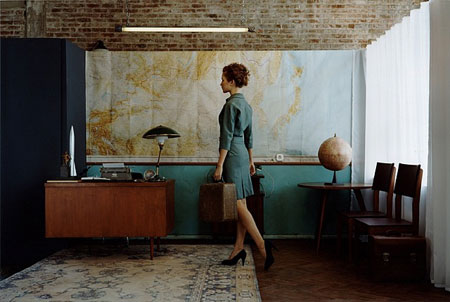
Continuing through May 20, 2012
As strange as it may sound, “Time-Lapse” starts small by starting big. Mary Temple’s “Currency” project, one of four installations that comprise the bulk of the exhibition, is an ambitious undertaking. Over the course of the past five years, Temple created “Currency” in response to the global political climate of the new century. Each portrait in the series — one per day, including images made during the exhibit’s duration — is taken from internet news images; the titles are a combination of the image caption and headline. “Currency” is designed to grow into the space as each new drawing is added in a calendrical format. It seems odd that so much empty space surrounds it in the early days of “Time-Lapse” but, as the show nears it’s end, that space will be filled. “Currency,” the most immediately accessible of the four installations, is also the least subjective.
Moving into the inner galleries, “Time-Lapse” becomes progressively more odd, unnerving, and engaging. Though Byron Kim’s “Sunday Painting” installation, like “Currency,” is designed to expand into the surrounding space, it does so at a slower rate, with new paintings added to the exhibition on a weekly, as opposed to daily, basis. Kim’s paintings are an exercise in subtlety. The subject is always the sky, painted from wherever he is on a particular Sunday. Slight variations exist in each due to atmospheric effects. Diary entries written on them mark the time and make the self-depricatingly titled “Sunday Paintings” something of an abstract self-portrait. Again, empty space would make one wonder why “Time-Lapse” isn’t more condensed — the exhibition inhabits a large footprint — if the visitor did not know it was evolving over time. It helps to know something about the show going in.
A small movie theater installed in one room presents the viewer with a film by Eve Sussman/Rufus Corporation (her production team). The film, “whiteonwhite:algorithmicnoir” is a dystopian, non-linear narrative edited in real time so that no two viewings are identical. Though the intent is for the viewer to provide a narrative thread for the imagery, how many people will make the intellectual leap? As a model, “whiteonwhite:algorithmicnoir” is a notable benchmark in experimental film, but a commitment to repeated viewings may be expecting too much for the vast majority of visitors. The model, nonetheless, fits the intent of the show overall, with a will to engage us and evoke a response.
It’s Rafael Lozano-Hemmer’s “Recorders” that completes the subjectivity of the experience. “Recorders” are interactive installations in which visitor participation is crucial for its effects. The most compelling is “Pulse Index,” a digital projection of your fingerprint and audio/visual capture of your heart-rate added to a grid of those of previous visitors. No two fingerprints being the same, Lozano-Hemmer’s “Pulse Index” completes the circuit of a continuously morphing, evolving show. Smartly curated and envisioned, “Time-Lapse” ends big by ending small, with the individualized mark of our transient lives.
